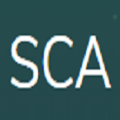In this paper, we study an unmanned aerial vehicle (UAV) communication system, where a ground node (GN) communicate with a UAV assisted by intelligent reflecting surface (IRS) in the presence of a jammer with imperfect location information. We aim to improve the achievable average rate via the joint robust design of UAV trajectory, IRS passive beamforming and GN's power allocation. However, the formulated optimization problem is challenging to solve due to its non-convexity and coupled variables. To overcome the difficulty, we propose an alternating optimization (AO) based algorithm to solve it sub-optimally by leveraging semidefinite relaxation (SDR), successive convex approximation (SCA), and S-procedure methods. Simulation results show that by deploying the IRS near the GN, our proposed algorithm always improves the uplink achievable average rate significantly compared with the benchmark algorithms, while deploying the IRS nearby the jammer is effective only when the jammer's location is perfectly known.
翻译:在本文中,我们研究了无人驾驶航空飞行器(无人驾驶飞行器)通信系统,地面节点(GN)在智能反射表面(IRS)的协助下与无人驾驶航空飞行器进行通信,而智能反射表面(IRS)则在位置信息不完善的情况下出现干扰。我们的目标是通过UAV轨迹、IRS被动波束成形和GN功率分配的联合稳健设计来提高可实现的平均速率。然而,由于无人驾驶航空飞行器的不凝固性和组合变量,配方优化问题很难解决。为了克服这一困难,我们建议采用基于交替优化的算法,利用半定点放松(SDR)、连续的convex近似(SCA)和Sproced方法来解决其次优化。模拟结果表明,通过在GN附近部署IRS,我们提议的算法总是大大改进可实现平均速率与基准算法的上,而只有在干扰器的位置完全为人所知时,才在干扰器附近部署IRS是有效的。




